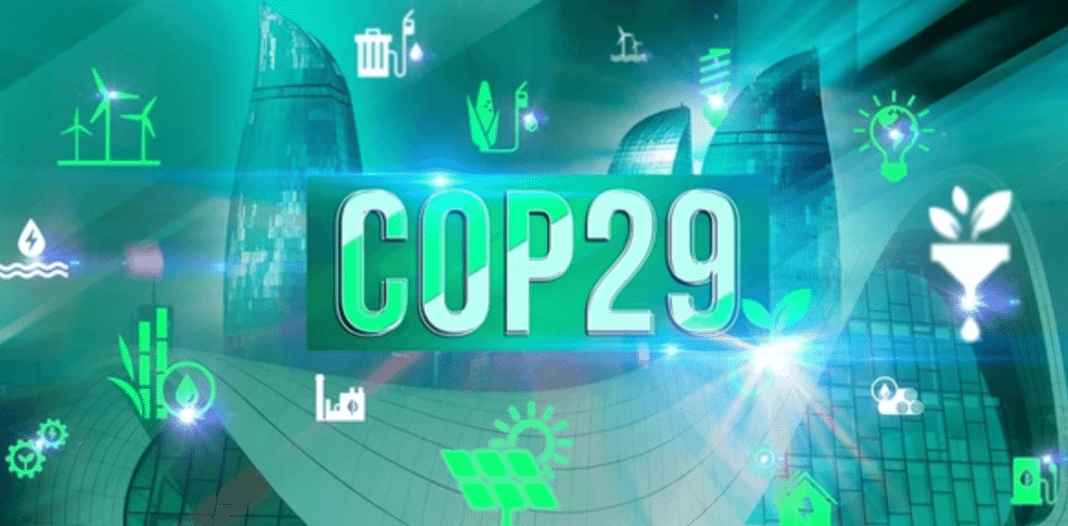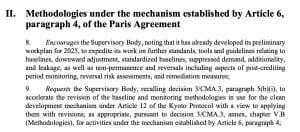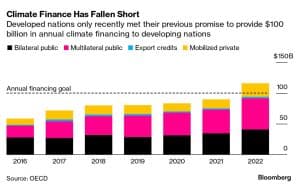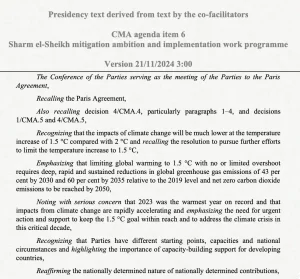The recently concluded COP29 in Baku marked another critical milestone in global climate action with mixed outcomes. Developed nations committed to channeling at least $300 billion annually into developing countries by 2035 for climate action. However, this fell short of the $1.3 trillion annual target demanded by developing nations.
The climate summit also finalized Article 6 on carbon markets, operationalizing the Paris Agreement nearly a decade after its inception. Meanwhile, key decisions on the global stocktake and fossil fuel transition were postponed to COP30 in Brazil. The negotiations occurred amidst political tensions, including Donald Trump’s re-election and potential U.S. withdrawal from the Paris Agreement.
Below we share our six key takeaways from this year’s climate talks.
Article 6: Carbon Markets Take Center Stage
Article 6 of the Paris Agreement, which deals with carbon market mechanisms, took center stage at COP29. After years of negotiation, the summit finalized mechanisms for global carbon trading.
Article 6.2 governs direct country-to-country carbon credit trading, while Article 6.4 establishes the Paris Agreement Crediting Mechanism (PACM), a centralized carbon market under UN supervision. It allows countries, corporations, and individuals to trade emission reduction units, referred to as A6.4ERs (Article 6.4 Emission Reductions Units).
The PACM introduces enhanced safeguards, including sustainable development tools and stricter methodologies to prevent “locking-in” high emissions. For example, it enforces baseline adjustments and “additionality” checks, ensuring projects generate genuine emission reductions.
These features aim to avoid pitfalls of past carbon market mechanisms, like the Clean Development Mechanism (CDM). Some projects under the CDM, such as afforestation, may transition into the PACM if they meet updated removal standards.
To prevent double-counting of credits, stringent rules for “corresponding adjustments” were introduced. For example, when a country sells emission credits, it must deduct the equivalent reductions from its own accounting, ensuring transparency and integrity.
Despite progress, experts remain cautious. While negotiators hailed the deal as a milestone, critics argue it oversells the mechanism’s potential to deliver large-scale mitigation. Concerns persist over transparency, particularly under Article 6.2, where “cooperative approaches” could lack stringent oversight.
To address these concerns, COP29 decisions require enhanced reporting and transparency in Article 6.2 activities and encourage swift finalization of PACM methodologies by 2025. These measures are pivotal for building trust and ensuring that carbon markets contribute meaningfully to global climate goals.
- Additionally, a “Share of Proceeds” mechanism was adopted, channeling 5% of transaction volumes and 3% of issuance fees into the Adaptation Fund. This provides critical resources for climate resilience in vulnerable regions while fostering global emissions reductions.
A New Era for Climate Finance
One of the most anticipated outcomes of COP29 was the agreement on a new collective quantified goal (NCQG) for climate finance. This goal seeks to replace the $100 billion annual target set at COP15, which had been criticized for being insufficient and inadequately mobilized. The NCQG represents a more dynamic, needs-based approach to climate financing.
At COP29, a new global climate finance target was introduced, aiming to raise $300 billion annually for developing countries by 2035. The goal includes public funds, development bank loans, and private investments mobilized by governments.
The NCQG has been a point of contention in climate talks. Developed countries are expected to provide significant funding, but developing nations argue that trillions of dollars are needed for their transition to cleaner economies.
The agreement also allows for “voluntary” contributions from nations like China, which have not traditionally provided climate finance.
Disagreements over the size and scope of the target caused delays and frustrations, with several drafts and revisions circulating before reaching a final agreement. Developed countries argue that global efforts must include a diverse range of contributors. As Jacob Levine, a senior director for climate and energy at the White House, stated:
“When you consider the magnitude…we need people to contribute, to do their fair share and to recognize the opportunity to work together.”
In contrast, developing nations, led by groups like the G77 and China, have insisted that developed countries bear the primary responsibility. Ali Mohamed, African Group Chair, remarked:
“We need equitable access for all developing countries. Cherry-picking certain groups won’t solve the global climate crisis.”
- The final agreement urges contributions from all sources, public and private, to meet a broader target of $1.3 trillion annually by 2035.
Mitigation Work Programme: Accelerating Action
The Mitigation Work Programme (MWP), established at COP26, received renewed attention at COP29. Delegates agreed to expand efforts to enhance renewable energy deployment and phase down unabated fossil fuel use.
However, progress has been limited to workshops and discussions. At COP28 in Dubai, negotiations faltered over whether the MWP should convey high-level political messages or remain strictly procedural. This stalemate carried into the Bonn negotiations in June 2024, with disagreements centering on linking the MWP to the global stocktake and its outcomes.
At COP29, these disputes persisted, particularly over including references to transitioning away from fossil fuels. Developing nations, represented by groups like the LMDCs and Arab states, opposed such language, citing concerns over top-down mandates.
Meanwhile, developed nations sought to integrate global stocktake results and emphasize stronger NDC updates. Paragraph 32 of an informal note, which mentioned the fossil fuel phaseout, proved particularly divisive, stalling discussions.
Despite efforts to revive negotiations in the summit’s second week, the final text (shown below) offered minimal progress. High-level political messaging was softened, with no explicit mention of the stocktake or fossil fuels.
While the dialogues under the MWP, focused on urban systems, were deemed productive, the adopted text primarily reaffirmed procedural elements, leaving substantial mitigation ambitions largely unresolved.
Adaptation: Scaling Resilience
Adaptation is one of the significant COP29 outcomes. Discussions focused on the Global Goal on Adaptation (GGA) and National Adaptation Plans (NAPs), yet progress was hindered by disagreements. The UAE-Belém work program, introduced at COP28, aims to establish indicators for adaptation targets, including resilience in water, ecosystems, and cultural heritage.
Midway through this two-year initiative, countries clashed over including “means of implementation” (MOI)—primarily financial support—and the concept of “transformational adaptation,” which developing nations feared might create obstacles to funding access.
The outcome included the “Baku Adaptation Roadmap,” softening MOI language to “enablers of implementation” to balance developed countries’ demands for governance and transparency with developing nations’ calls for financial support. While this compromise acknowledged both sides, it left many countries dissatisfied, particularly those advocating for robust financial commitments.
NAP discussions, initially slated to conclude in week one, also experienced delays due to extensive disagreements. By week two, facilitators proposed procedural conclusions, deferring substantive decisions to Bonn in June 2025. Other adaptation-related matters, such as the adaptation fund and performance reviews, were similarly postponed.
The roadmap’s adoption and continued GGA discussions underscore adaptation’s complexity and urgency as climate impacts intensify. COP30 is expected to revisit unresolved issues, including financial commitments and equitable adaptation frameworks.
Loss and Damage Fund: A Historic Step
COP29 marked a turning point with the operationalization of the Loss and Damage Fund, initially agreed upon at COP27. This fund aims to provide financial support to nations suffering from climate-induced disasters such as hurricanes, floods, and sea-level rise.
The fund’s governance structure ensures equitable distribution of resources, prioritizing least-developed countries and small island developing states (SIDS). Discussions also explored innovative funding sources, including levies on fossil fuel exports and international shipping, to sustain the fund over the long term.
The operationalization of this fund underscores the principle of climate justice, acknowledging the disproportionate impact of climate change on vulnerable populations.
Still, loss and damage funding remained contentious at COP29. While the fund advanced with pledges rising to $759 million, developing nations criticized the insufficient funding.
UN chief António Guterres highlighted the lack of justice for vulnerable nations. He stated that the fund’s capitalization falls far short of addressing the need.
- According to a study, climate change damage costs the world between $1.7 trillion and $3.1 trillion each year by 2050.
Negotiators failed to include loss and damage in the new climate-finance goal (NCQG), as developed countries resisted expanding finance obligations. Discussions on the Warsaw International Mechanism (WIM) and Santiago Network stalled due to disagreements, with progress deferred to mid-2025.
The UAE’s Global Stocktake
The UAE-hosted conference underscored its role as a key stakeholder in global climate action through the first-ever global stocktake (GST). This assessment measured the world’s progress toward the Paris Agreement goals, providing a clear picture of where nations stand on mitigation, adaptation, and finance.
At COP29, climate talks became contentious as nations grappled with commitments from COP28’s GST. The UAE’s approach to discussions about fossil fuel transitions sparked debate.
Developed nations and vulnerable countries demanded stronger commitments for transitioning away from fossil fuels, while Saudi Arabia opposed the inclusion of specific fossil fuel language, emphasizing the need for finance-focused discussions. This clash led to diluted draft texts and an impasse on key issues.
In the end, the UAE dialogue was postponed until the 2025 talks, leaving many disappointed. However, COP30 in Brazil holds the potential for renewed momentum, especially in terms of accountability and climate action.
Conclusion
The COP29 outcomes in Baku delivered a mix of progress and challenges, with significant advancements in climate finance, carbon markets, and adaptation efforts. The outcomes reflect a growing recognition of the need for collective action to address the climate crisis.
- READ MORE: Article 6.2 at COP29: Singapore Partners with Gold Standard and Verra to Advance Climate Action
The focus now shifts to implementing these agreements and bridging gaps in ambition, funding, and delivery. As the world gears up for COP30, the lessons from Baku will serve as a critical foundation for driving forward the Paris Agreement goals.





